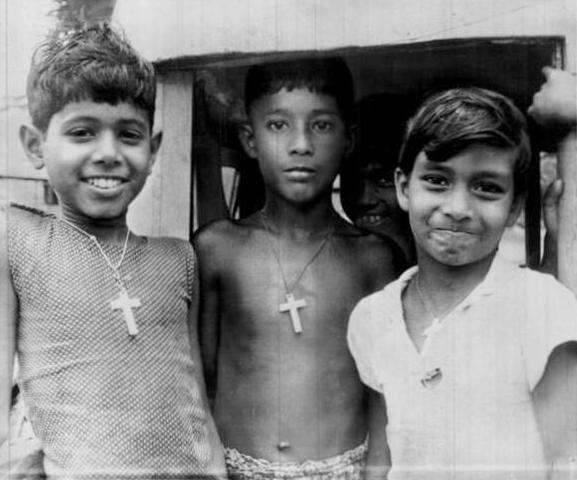
Modern Pakistani History: Civil War--East-West Split (1971)

Figure 1.--This press photo was taken East Pakistan during the Pakistani Civil War (August 5, 1971). The caption read, "Cruifixes for protection: Three Hindu boys wear cruifixes in Jalirpar where frightened Hinfus have beseigedChristian missionaries for conversion in the belief that Pakistani soldiers will not harm them if they wear crucifixes. The Hindus hasve been tsargets of military operationsd than began March 25 when West Pakistani troops moved in to quell the East Pakistani separtist movement. Photographer: Arnold Zeitlin.
|
|
Tensions between East and West Pakistan existed from the creation of Pakistan (1947). Pakistan was an odd creation woth the two parts, East and West Pakistan separated by more than 1,000 miles. The two parts of Pakistan shared few cultural and social traditions other than Islam. The lack of common bonds was accentuated when political figures in the West seized control of the new state, dominating both political and economic power. This causes resentment in East Pakistan that gradually grew. East Pakistan's Awami League, led by the Bengali leader Sheik Mujibur Rahman, won a majority of the seats in the National Assembly (1970). President Yahya Khan responded by postponing the opening of the National Assembly to prevent the Awami League from pursuing greater autonomy for East Pakistan. The result was civil war.
Begali nationalists declared independence (March 26, 1971). The Pakistani Army attempted to regiain control in East Pakistan and committed terrible attrocities. Indian troops entered the war and quickly defeated the Pakistani Army. The Pakistanis conceded defeat (December 16, 1971). President Yahya Khan resugned. Zulfikar Ali Bhutto took over Pakistan and recognized Bangladesh as an independent country. Formal diplomatic relations were initiated (1976).
Geographically Divided Nation
Tensions between East and West Pakistan existed from the creation of Pakistan (1947). Pakistan was an odd creation woth the two parts, East and West Pakistan separated by more than 1,000 miles. The two parts of Pakistan shared few cultural and social traditions other than Islam. The fusion of east and west on the basis of Islam led to the frustration of Bengali nationalism. The lack of common bonds was accentuated when political figures in the West seized control of the new state, dominating both political and economic power. The military governments which gave little attention to political demandsc in East Pakistan only promoted discord. As aresult, the resentment in East Pakistan gradually grew.
Awami League
The Awami League was founded as a an opposition party in East Pakistan soon after Pakistani independence (1949). The League has a moderately socialist ideology as was widespread in the new independent countries emerging from European colonial empires. Cofounder Sheikh Mujibur Rahman assumed leadership a few years later (1953). Disturbed by the dominate role of West Pakistan leasers, Rahman
demabded amore equitable distribution of power (1966). His plasn called for a federation of East and West Pakistan which would have given EastPakistan a level of autonomy.
1970 Election
East Pakistan's Awami League, led by the Bengali leader Sheik Mujibur Rahman, won a majority of the seats in the National Assembly (1970). President Yahya Khan responded by postponing the opening of the National Assembly to prevent the Awami League from pursuing greater autonomy for East Pakistan.
Civil War (1971)
President Khan's actions preventing the opening of the National Assembly led to disorders in East Pakistan as people began porotesting in the street. The Government in West Pakistan banned the League. The result was civil war (early 1971). Begali nationalists declared independence (March 26, 1971).
The Alami League did not have a conventional army. As a result, they launched a guerrilla campaign (March 1971). The Pakistanu Army resonded with a bloofy counter-insurgency effort. Te Pakistani Army was primarily a West Pakistan force and they tended to see the East Palistanis as both alien and disloyal. A further complication was the Hindu minority in East Pakistan. The almost entirely Muslim Pakistani Army saw them as essentially an Indian Fifth Collumn. Thus the Army's attempt to regiain control in East Pakistan resulted in large numbers of civilian casualties. The Army committed terrible attrocities. An estimated 10 million East Pakistanis fled to India to escape the fighting and Army reprisals. India itself for months did not intervene, but provided military equipment and supplies to the Bengali resistance. Pakistan decided to force a conclusion and launched a preemtive air strike on India (December 3, 1971).
Third Indian-Pakistani War (December 1971)
Indo-Pakistani relations deteriorated yet again. This time the civil war in East Pakistan was the principal cause. After Pakistani air strikes, Indian troops entered the war (December 1971). India invaded East Pakistan in part in response to the chsarges of attrocities and the wave of refugees entering India. Pakisdtan conducted air raids on Indian air ports ad airfields. Indians Prime Minister, Indira Gandhi, addressed the nation by radio and proclaimed that the the Pakistani war against Bangladesh has become one against their homeland.
The Indians quickly defeated the Pakistani Army. The Pakistani army surrendered at Dhaka (December 16, 1971). More than 90,000 Pakistanis, mostly West Pakistanis, became Indian prisoners of war. President Yahya Khan resigned.
Bangladesh Independence
East Pakistan became the independent as Bangladesh (December 6, 1971) .Zulfikar Ali Bhutto took over Pakistan and recognized Bangladesh as an independent country. Formal diplomatic relations were initiated with Pakistan (1976).
HBC

Navigate the Boys' Historical Clothing Web Site:
[Return to the Main Pakistani history page]
[Return to the Main Pakistani page]
[Return to the Main Asian history page]
[Introduction]
[Activities]
[Biographies]
[Chronology]
[Cloth and textiles]
[Clothing styles]
[Countries]
[Topics]
[Bibliographies]
[Contributions]
[FAQs]
[Glossaries]
[Images]
[Links]
[Registration]
[Tools]
[Boys' Clothing Home]
Navigate the Boys' Historical Clothing national pages:
[Return to the Main countries page]
[Australia]
[Belgium]
[England]
[France]
[Germany]
[Ireland]
[Italy]
[Japan]
[Korea]
[Malaysia]]
[Mexico]
[Pakistan]
[Scotland]
[United States]
Created: 1:36 AM 6/1/2010
Last updated: 1:36 AM 6/1/2010



